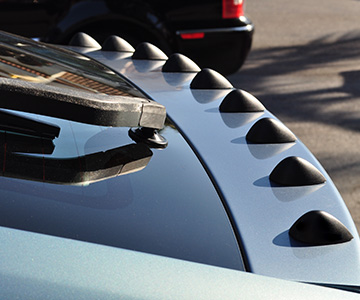Prius – 11% Better Fuel Economy
June 24, 2024Pod Performance for AeroDynamic Vehicles
Where to place AeroHance Pods to better fuel economy on aerodynamic designed vehicles, like the Toyota Prius. Vehicles that are shaped like an aerodynamic pod. Vehicles that are AeroHance Pods.
The deciding factor for AN to buy a Prius was when he read about its innovative use of regenerative braking. Regenerative braking represents a productive redirection of available resources. Similar in spirit, AeroHance Pods elegantly and passively channel air that would otherwise become turbulent into the stream-wise flow.

With a kit of 9 AeroHance Pods installed across the rear spoiler of his Toyota Prius, AN logged mileage over 2010 miles of driving, documenting an average 43 mpg. 2055 miles of baseline (no pods) mileage was 38.8 mpg. That is 11% over the increase, and consistent with reports provided by others driving Classic Prius, and similar to results provided by drivers of Honda Insight, with its similar body type.
The way in which air moves past all vehicles is consistent in one manner. There is a streamwise flow of air speeding past the vehicle. Immediately behind the pressure is less than that of the air speeding past. Where airflow speeding past meets the low pressure behind there is turbulence or drag. This turbulent airflow pulls back against your car’s forward momentum and makes your engine work harder. One way to increase fuel economy is to reduce the size and effect of this turbulent flow.
The sweet spot for placement is just before the air turns from stream-wise to turbulent.
AeroHance Pods are aerodynamic devices that channel more air into that low-pressure area, reducing its size and while adding more air to the fast-moving stream-wise flow. The sweet spot for placement is just before the air turns from stream-wise to turbulent, that is just before the air separates from the rear of the vehicle.
By design, the aerodynamic slope of the Prius rear windshield maintains streamwise flow longer than boxier-shaped vehicles. We found that this results in optimum placement for AeroHance Pods further back, across its rear trailing edge.
(This is different than boxier shaped vehicles such as the PriusV, Volkswagen Golf and Toyota Matrix, Station wagons, like my own Volvo 760XC, Vans like the Ford Transit Connect, and most SUV. Computational Fluid Dynamic Analysis and AeroHance Team Member reports have consistently shown optimum results with placement 7″-10″ forward of the rear roofline for these flat back vehicles.)
With AeroHance Pods on the rear spoiler of his Classic Toyota Prius, AN was able to consistently top 50 mpg on his freeway drives. During the 2-month term of testing, AeroHance Pods bought AN 2 extra gallons of gas. At current gas prices, AeroHance Pods paid for themselves during the three months term of his test. He has siince saved $60 per year. They reduce his carbon footprint each year by 600 lbs.

